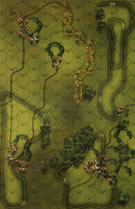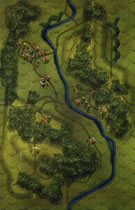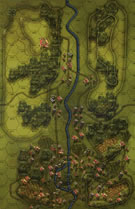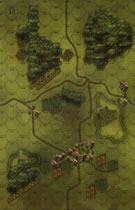|
They Shall not Pass! Fall of France 1 #28 |
||
|---|---|---|
| (Attacker) Germany | vs | France (Defender) |
| Formations Involved | ||
|---|---|---|
| France |  |
Groupement Marioge |
| Germany |  |
28th Infantry Division |
| Germany |  |
5th Panzer Division |

|
| Overall Rating, 9 votes |
|---|
|
3.78
|
| Scenario Rank: 233 of 957 |
| Parent Game | Fall of France 1 |
|---|---|
| Historicity | Historical |
| Date | 1940-05-18 |
| Start Time | 10:00 |
| Turn Count | 24 |
| Visibility | Day |
| Counters | 108 |
| Net Morale | 1 |
| Net Initiative | 1 |
| Maps | 4: 26, 29, 30, 31 |
| Layout Dimensions | 86 x 56 cm 34 x 22 in |
| Play Bounty | 122 |
| AAR Bounty | 142 |
| Total Plays | 8 |
| Total AARs | 5 |
| Duplicates | FoF2032 |
| Battle Types |
|---|
| Bridge Control |
| Covering Action |
| Inflict Enemy Casualties |
| River Crossing |
| Rural Assault |
| Urban Assault |
| Conditions |
|---|
| Entrenchments |
| Off-board Artillery |
| Reinforcements |
| Terrain Mods |
| Scenario Requirements & Playability | |
|---|---|
| Fall of France 1 | Base Game |
| Introduction |
|---|
|
The Maubeuge fortified sector was part of the old World War I fortress line along the Belgian border. It had been re-built along the Sambre River as a kind of secondary extension of the Maginot line. Following the failure of the Dyle plan and subsequent German moves southward to cut the retreat of the French armies, some utterly exhausted French troops were assigned to hold the line along with the garrisons there. The Frenchmen on the line knew that they were just waiting for the Germans to close the noose around them, but their orders were to delay the enemy advance at any cost. |
| Conclusion |
|---|
|
The south bank of the Mauberge was defended by the casements of Marpent, while on the north bank the mixed collection of French units under Lt. Col. Marioge made a desperate effort to defend the few bridges which had not yet been destroyed. The Germans attacked the southern casemates on the morning of the 18th and took them one by one that afternoon despite powerful defensive fire from the fort at Boussois. Meanwhile, Germans coming from the city of Maubeuge hit the French from another direction. On the Assevent bridge, scattered infantry elements and several German attempts to cross the river and held the bridge until nightfall. Groupement Marioge held out for several days, but their fate was sealed from the outset. The fort at Boussois was the last of the Mauberge Line to fall, capitulating under massive bombardments and engineer attacks on May 21st. |
| AFV Rules Pertaining to this Scenario's Order of Battle |
|---|
|
| 5 Errata Items | |
|---|---|
| Scen 28 |
Germans have a PzIVa, not PzIIIa. (PG-Tank Dude
on 2010 Apr 30)
|

|
Two 105mms (ID#s 1204, 1205) have "16-31" fire values in black (direct fire), when they should be in white (indirect fire). (Shad
on 2010 Dec 15)
|

|
The reduced direct fire value of the Heer HMG became 5-5 starting with Fall of France. (plloyd1010
on 2015 Jul 31)
|

|
The morale and combat modifiers of German Sergeant #1614 should be "0", not "8". (Shad
on 2010 Dec 15)
|

|
The movement allowance on the counters in Airborne is misprinted. It should be "3." (rerathbun
on 2012 Jan 30)
|
| They Shall Not Pass! |
|---|
|
Big scenario (a lot of units and four mapboards). Three groups of German units must attack French positions strongly defended. The Germans must take two bridges, ten entrenchments and some town hexes. The French have casemates, minefields and a powerful artillery. Both sides have tanks. Given the great number of objectives to conquer, the great number of units and the game lenght (24 turns), the Germans must coordinate their leaders to activate as many as possible units before the end of each turn (I play with the Fog of War rule). Also, the Germans must advance hidden as far as possible to avoid the effects of the French artillery. The game is exciting. The Germans conquer objectives little by little, fighting against the French and the clock. In the end the Germans win (major victory). This is one of the best scenarios I have ever played. Victory Points: Germans 75, French 49. |
| 0 Comments |
| Germans Everywhere ! At Our Front, At Our Sides and Crossing The River | ||||||||||||||
|---|---|---|---|---|---|---|---|---|---|---|---|---|---|---|
This one was played ftf with Wayne Baumber, our second go at one from FOF, and boy have they been good so far ! This scenario will give both the defender and attacker many options of deployment, defensive sectors and points of attack, to make it eminently replayable with different opponents. It has defended bridges, minefields, Maginot line type casements, river crossings, tough French tanks and ........ well, just play it ! How It Started The German attack began around 1000 hours. As expected it came from the west from Maubeuge itself. The main assault infantry units, coming along the north bank of the river, and other elements, such as two platoons of Panzers on the south bank. Another section of German troops also came from the south itself and set themselves against the casemates. The French positions appeared to have been well-thought out? Small headway was made by the German infantrymen, if any at all. When initial contact was made, French fire proved very effective! The Boussois fortress instantly repulsed a first probe against it, cutting down the enemy in a stroke. French bombardments were punishing, and the west flank held like a wall as each section of it appeared to be able to cover one anothers section and French command there was also of a good quality. By 1045, the Germans were already counting a 100 or so casualties. But the French troops now begun to sustain losses too. One outer casemate had been taken, and their reservist troops were the units suffering under German bombardment. In all, about the same amount of losses as the Germans. But the French lines on either flank were still solid. Lone Mortar Platoon Scores A "Critical Hit" At 1100 hours, the Germans secured their first success in the attack. A lone mortar platoon had been bombarding the entrenched area on the front of the French western line. In doing so, it inflicted some very surprising hits in the area and had forced some of the defenders there to seek cover. Seeing this rare moment of opportunity, the German line pushed forward as the French tried to rearrange their line. French armour here appeared not to be too well commanded and its target selection poor. Within 15 minutes, the German infantry had hit the French line in close assaults and were extracting a heavy toll on the enemy. In the 30 minute struggle, 50 German casualties were exchanged for 150 French losses, 8 tanks and the falling of the first line of defence. Most of the French here managed to extricate themselves and set about forming a new line of defence. As they did this, the Germans themselves needed to stop for breath and re-organisation. During this relative lull, the French managed to pick-off a few more German infantrymen, but by 1230 hours, the Germans had begun probing again. In one sector of the French line, 75 casualties were sustained during a 15 minute bombardment as demoralized troops ran into the line held by their good-order comrades. The over-crowding exacerbated the situation and the resultant losses upon the panic-stricken defenders seemed needless. From here on, for another hour, this second and reformed French line came under intense pressure as 4 more of their tanks and some 200 other troops had either fled, or become a casualty. Even the Lt Col of the regiment had deserted his post to the utter disgust of Wayne. Across The River ! - Pontoons and Bridges On the German right, persistent attempts by their engineer company at various points along the bank eventually succeeded in placing a flimsy wooden pontoon across the river. This had been done even though the plentiful French OBA had shelled them constantly. Nonetheless, 75 engineer casualties had been sustained in the attempt, but the whole French line was now being stretched. By 1400 hours, a small trickle of German infantry had begun to cross to the other side of the Sambre, but at this stage, this was not quite enough. On the German left, a platoon each of Pz IV’s and I’s on the southern bank were now shelling and machine gunning French defenders that were well entrenched on the bridge there, whilst German infantry, commanded by their Major were engaging French infantry protecting the northern approach to the bridge in a small village located there. The French here had been reduced to a platoon, but were holding off three times their number in a desperate struggle to keep control of the bridge. The Bridge Is Taken By 1415, the battle was on a knife-edge. The Germans had pushed forward well, but needed to complete the capture of at least one of the bridges and a few more entrenchments and town areas by the time evening drew in. Just 2 more hours and the French would have succeeded in stalling the Germans far longer than would have been acceptable. But the tipping point was not far off. At 1430 hours the German attacks on the bridge and the town north of it finally yielded success. The Frenchmen that had defended so ably there had finally taken all they could and were beginning to crumble against the forces being thrown at them. Casualties were mounting unacceptably and morale sinking. By 1445, both the bridge and its environs were firmly in German hands. The Panzers there would be able to cross now and push forwards against an ever-dwindling enemy. The Pontoons Repulsed The French did however score a success on the right. They continued to concentrate all their OBA on the German engineers trying to build a pontoon for the waiting infantry to cross. Though a to and fro affair, the OBA effectively curtailed any efforts across the river by continually disrupting the German efforts and this enemy force, having thought better of trying to cross the river, decided to swing round toward the French casements instead. But by now, it was all over. German forces on the left were finally squeezing up having battled against and punctured successive French defence lines, and with German tanks speeding along the road ever deeper into the French ranks, the Allied commander conceded the battle. Casualties German - 13 steps (counting as 13 VC step losses) French - 41 steps (counting as 50 VC step-losses) With the Germans also taking one bridge and 3 entrenchments and the result points for them, this meant that the Germans attained a Major Victory. In my view, a great scenario. Play it with an opponent ! Major victory for the Germans is something of a flattery really. The French really did contest this battle and made it very hard indeed. Their positioning of the casements and minefields were perfect and to all purposes, these were not breached. Had the Northern sector held up with its morale better (and on another day, it may have), the result could certainly have been different. I guess the other factor was that they simply did not eliminate enough of the enemy. With all that OBA, maybe they should have ? This would have cut down the VC pts deficit |
||||||||||||||
| 0 Comments |
| They did not pass ! | ||||||||||||||
|---|---|---|---|---|---|---|---|---|---|---|---|---|---|---|
I think this is a good scenario, but not an easy one. My opponent made two mistakes in his setup : he did not setup forces to slow down the German advance, and his casemate were not well setup. Nevertheless, I was too unprepared for the attack and my tactical choices were wrong. Part of my forces entered north of the river and took the first bridge without resistance. I concentrated the rest of my forces on the second bridge, and this is my greatest mistake as the French was able to concentrate his resistance there. I think the German has to spread so as to have many points of river crossing. I think also the French OBA is very strong, maybe too much. I still have to learn tactics of PG. En route for the next scenario ! |
||||||||||||||
| 0 Comments |
| They shall not pass (quickly) | ||||||||||||||
|---|---|---|---|---|---|---|---|---|---|---|---|---|---|---|
The title of this AAR refers to the length of time to finish this scenario. Due to snow,holidays and work this has taken nearly 6 weeks to complete. A good scenario though, with good German infantry fighting through French reserves,artillery and casements to cross. a major river. The French initial line held well but caved in at a most inoppertune moment. The Germans used engineers to outflank French forces and crossed the river to the rear of the French postions. However French artillery pounded the pontoon bridges and stopped the flow of forces crossing. The Germans though kept pressing and soon broke through the second French line, thus releasing the Panzers to roam around the French lines. At this point the French realising the game was up conceded. A major victory for the Wermacht. Excellent scenario this, with lots of replay value. Give it a try! |
||||||||||||||
| 0 Comments |
| They Shall Not Pass (Revisited) | ||||||||||||||
|---|---|---|---|---|---|---|---|---|---|---|---|---|---|---|
This is the second time I've played this scenario and the second time I've played it as the French and the second they have been reasonably easily defeated. The scenario has a large force mainly of German INF advancing from the western board edge bisected by a river, with further troops stationed to the south of the river, and a third force arrives with also from the south this time with ENG support presumably to assist in crossing the river. The French have a force roughly equal in numbers to the Germans but lacking in quality nearly half of them being reservists. To offset this the French have good OBDA, Casemates, entrenchments and 4 R35 tanks. VP are awarded for holding town hexes, entrenchments and the two surviving bridges over the major river. VP's are also given for eliminating steps. The rather contrived set up restrictions for French mean they have to set up six hexes away from the board edge, the minefields and casements set up away from the main German thrust and will possibly play only a very minor role in the battle. In our game the Germans surged forward capturing 15 town hexes in the west with little French opposition, they then captured a couple of entrenchments and already managed to get a lead in VP's. As the French plyer I should have counterattacked more strongly instead of relying on my two 42 strength bombardments to kill sufficient Germans to swing the game towards the French. Tony R even managed to cross the river using his ENG and threaten some of the Eastern VC hexes. A little end run with my solitary A/car to recapture town hexes ended in abject failure and the French command conceded the battle on GT20. I have revised my marking for this scenario down to a 3 as it appears to be balanced in favour of the Germans, but its a good scenario and worthwhile playing. Should the French OBDA be very accurate I suspect that the Germans could have a harder time of it than my two plays. |
||||||||||||||
| 0 Comments |

 FaoF027
FaoF027 






























